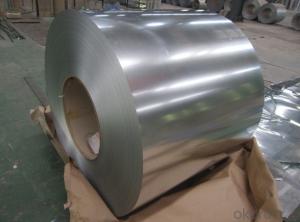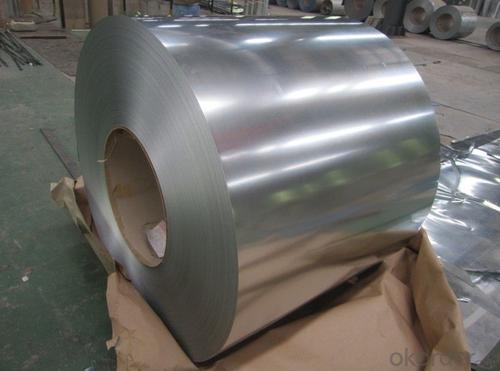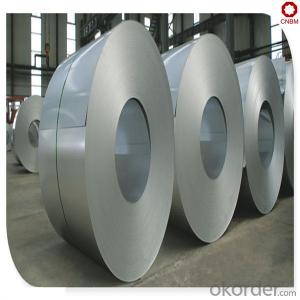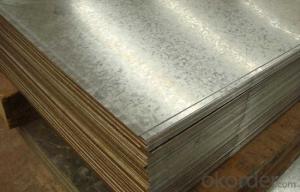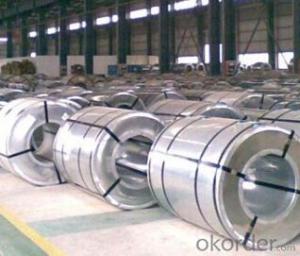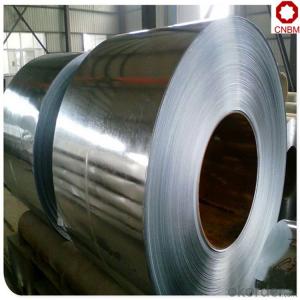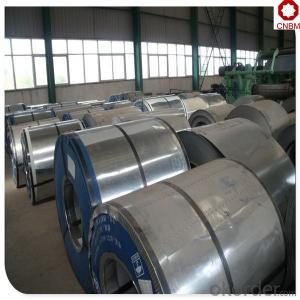Hot-dip Galvanized Steel Coil DX51D+Z with Best Price
- Loading Port:
- China main port
- Payment Terms:
- TT OR LC
- Min Order Qty:
- 50 m.t.
- Supply Capability:
- 10000 m.t./month
OKorder Service Pledge
OKorder Financial Service
You Might Also Like
Specification
1.Hot-dip Galvanized Steel Coil DX51D+Z with Best Price
Hot-dip galvanized steel coils are available with a pure zinc coating through the hot-dip galvanizing process. It offers the economy, strength and formability of steel combined with the corrosion resistance of zinc. The hot-dip process is the process by which steel gets coated in layers of zinc to protect against rust.
2.Main Features of the Hot-Dip Galvanized Steel Sheet:
• Excellent process capability
• Smooth and flat surface
• Workability, durability
• Good visual effect
3.Hot-Dip Galvanized Steel Sheet Images
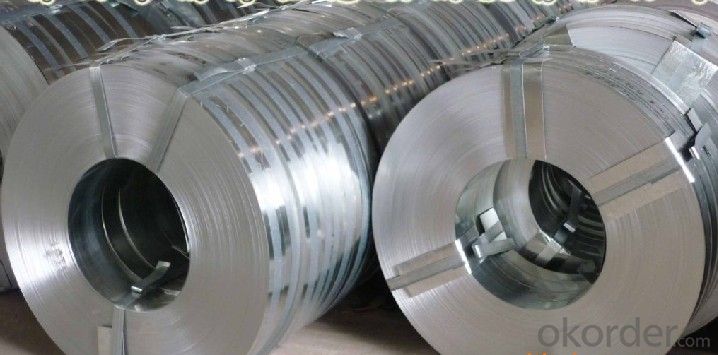

4.Hot-Dip Galvanized Steel Sheet Specification
Standard: ASTM, JIS,EN
Grade: CS, DX51D+Z,SGCC, SS 230~550,S220GD+Z~S550GD+Z, SGC340~SGC570
Thickness: 0.18mm~5mm
Width: max 2000mm
Coil weight:3-12 MT
Coil ID:508/610mm
Surface structure: zero spangle, regular spangle or minimum spangle
Surface treatment: Chromate treatment, Oiled/dry, skinpassed/non-skinpassed
Packing: Standard seaworthy export package
5.FAQ of Hot-Dip Galvanized Steel Sheet
We have organized several common questions for our clients,may help you sincerely:
1.How to guarantee the quality of the products?
We have established the international advanced quality management system,every link from raw material to final product we have strict quality test;We resolutely put an end to unqualified products flowing into the market. At the same time, we will provide necessary follow-up service assurance.
2. How long can we receive the product after purchase?
Usually within thirty working days after receiving buyer’s advance payment or LC. We will arrange the factory manufacturing as soon as possible. The cargo readiness usually takes 15-30 days, but the shipment will depend on the vessel situation.
- Q: How are steel coils used in the HVAC industry?
- Steel coils are commonly used in the HVAC industry for various purposes such as heat transfer, refrigerant circulation, and air conditioning. They are typically found in heat exchangers, condensers, and evaporators, where they help in transferring heat between air and refrigerant. Steel coils play a crucial role in maintaining the desired temperature and providing efficient cooling or heating in HVAC systems.
- Q: What are the safety precautions to be taken while handling steel coils?
- When handling steel coils, several safety precautions should be followed to minimize accidents and injuries. Some of the key safety measures include: 1. Personal Protective Equipment (PPE): Wearing appropriate PPE, such as safety gloves, steel-toed boots, and protective eyewear, is essential to protect against potential hazards like cuts, impacts, and eye injuries. 2. Proper Lifting Techniques: Using correct lifting techniques, such as bending the knees and using leg muscles instead of the back, helps prevent strains and back injuries. It is also important to seek assistance or use lifting equipment when dealing with heavy coils. 3. Secure Storage and Handling: Coils should be stored in a stable and secure manner, ensuring they are properly stacked and restrained to prevent them from tipping or falling. Adequate space should be provided between stacks to allow safe movement around them. 4. Inspection and Maintenance: Regularly inspecting coils for any defects, such as sharp edges, loose straps, or damaged packaging, helps prevent accidents. Damaged coils should be repaired or replaced, and any loose materials or debris should be removed. 5. Proper Handling Equipment: Using appropriate handling equipment, such as coil lifters or forklifts, ensures safe transport and manipulation of steel coils. Operators should be trained in the correct use of such equipment to minimize the risk of accidents. 6. Communication and Signage: Clear communication among workers and proper signage indicating potential hazards, load capacities, and designated walkways can help prevent accidents and ensure a safe working environment. By following these safety precautions, the risk of accidents, injuries, and damage associated with handling steel coils can be significantly reduced.
- Q: How are steel coils used in the production of HVAC ductwork?
- Due to their durability and strength, steel coils find widespread use in the production of HVAC ductwork. Galvanized steel is typically used to make these coils, as it offers protection against corrosion and extends the lifespan of the ductwork. To initiate the manufacturing process, the steel coils are unrolled and cut to the desired length. Subsequently, they are passed through a machine that shapes the steel into either a rectangular or round duct form. This shaping process employs various techniques like roll forming or press braking. Once the steel has taken the desired duct shape, it is joined together using different methods such as welding or locking mechanisms. Rectangular ducts are commonly welded, while round ducts often incorporate locking mechanisms like snap locks or Pittsburgh seams. These joining techniques ensure the ductwork is secure and airtight. Following the assembly of the ductwork, additional processes like insulation or lining may be applied. Insulation aids in minimizing heat loss or gain, while lining improves the acoustic properties of the ductwork. These supplementary steps are often undertaken to comply with specific requirements or regulations. In conclusion, steel coils are essential in the production of HVAC ductwork due to their strength, durability, and corrosion protection. Steel's versatility allows for the fabrication of ductwork in various shapes and sizes, making it a popular choice for HVAC systems.
- Q: What are the challenges in coil blanking?
- In order to achieve efficient and accurate production, coil blanking, a process used to cut flat metal sheets from coiled stock, must tackle several challenges. Some of the key challenges include: 1. Material variations: Coiled stock can have variations in thickness, width, and surface quality, which can impact the cutting process and result in inconsistent blanks. To ensure consistent quality and dimensional accuracy, it is crucial to carefully select and control the material. 2. Coil set and crossbow: Coiled stock often has inherent shape imperfections like coil set (longitudinal curvature) and crossbow (transverse curvature), which can cause alignment issues during cutting. Minimizing these imperfections requires the use of specialized equipment and techniques, such as straighteners and leveling systems. 3. Coil edge condition: The edges of coiled stock can have burrs, waves, or irregularities, which can affect the quality and precision of the cut blanks. Employing proper edge conditioning techniques, like deburring or edge trimming, is necessary to ensure clean and straight edges. 4. Slitting and shearing forces: The forces exerted during coil blanking can induce stresses and strains in the material, potentially leading to deformation or springback. To minimize these effects and maintain dimensional accuracy, careful consideration of slitting and shearing forces, along with proper tooling design and machine settings, is necessary. 5. Scrap and material waste: Coil blanking can generate significant amounts of scrap material, especially during setup and adjustment phases. Managing scrap and reducing material waste is crucial to optimize production efficiency and minimize costs. Efficient nesting algorithms and real-time monitoring systems can help achieve this. 6. Automation and productivity: Due to market demands, coil blanking often requires high-speed and high-volume production. Enhancing productivity can be achieved through the implementation of automation systems, such as robotic material handling and advanced control systems. However, integrating and synchronizing these components with the cutting process requires careful planning and system integration expertise. Overall, addressing these challenges in coil blanking necessitates proper material selection, advanced equipment, specialized techniques, and efficient process control. By overcoming these challenges, manufacturers can achieve consistent quality, dimensional accuracy, and productivity in coil blanking operations.
- Q: How are steel coils used in the production of food processing equipment?
- Steel coils are commonly used in the production of food processing equipment due to their various advantageous properties. These coils, typically made from stainless steel, are used in the manufacturing of a wide range of equipment such as mixers, blenders, conveyors, ovens, and fryers. One of the main reasons steel coils are used in food processing equipment is their excellent resistance to corrosion. Stainless steel coils are highly resistant to rust and can withstand exposure to moisture and various food substances without deteriorating. This is crucial in ensuring the equipment remains hygienic and safe for food processing. Additionally, steel coils provide exceptional strength and durability, allowing food processing equipment to withstand heavy use and harsh operating conditions. The coils can be formed into different shapes and sizes, enabling the fabrication of complex equipment components. This versatility facilitates the design and construction of equipment that is both efficient and reliable in processing various food products. Furthermore, steel coils are easy to clean and maintain. The smooth surface of stainless steel makes it resistant to staining and facilitates the removal of food residues, preventing the growth of bacteria. Regular cleaning and sanitization of food processing equipment are essential for maintaining food safety standards, and steel coils make this process easier and more effective. Moreover, steel coils have excellent heat conductivity properties, allowing for efficient heat transfer in food processing equipment such as ovens and fryers. This enables precise temperature control and uniform cooking, ensuring consistent quality of processed food products. In summary, steel coils play a vital role in the production of food processing equipment by providing corrosion resistance, strength, durability, ease of cleaning, and efficient heat transfer. These qualities make steel coils an ideal material for manufacturing equipment that meets the high standards of hygiene, safety, and quality required in the food processing industry.
- Q: How are steel coils inspected for bendability using bend testers?
- Steel coils are inspected for bendability using bend testers, which are specialized machines designed to measure the flexibility and bend resistance of the coils. The process involves several steps to ensure accurate and reliable results. Firstly, the steel coil is prepared by securing it firmly in place, usually using clamps or other mechanisms to prevent movement during testing. This ensures that the coil remains stable and allows for consistent and repeatable measurements. Next, the bend tester is set up according to the specified testing parameters. These parameters typically include the desired bend angle, the speed at which the bend is applied, and the number of cycles to be performed. The bend tester is equipped with a bending mechanism that exerts a controlled force on the coil, simulating the bending conditions it may undergo during its application or use. Once the bend tester is set up, the bending process begins. The machine applies a gradually increasing force to the steel coil until it reaches the desired bend angle. This force is carefully measured and monitored throughout the process to ensure accuracy. During the bending process, the machine records and displays important data, such as the applied force, the angle of bend, and any indications of cracking or other defects. This data is crucial for evaluating the bendability of the steel coil and determining whether it meets the required standards. After the desired bend angle is reached, the coil is released from the bending mechanism, and any residual stresses are allowed to relax. This relaxation period is important to observe any potential spring-back effect, where the coil partially returns to its original shape after bending. The amount of spring-back is also measured and recorded for further analysis. Finally, the inspection results are analyzed to determine the overall bendability of the steel coil. If the coil meets the specified bendability criteria, it can be considered acceptable for its intended application. However, if any cracks, fractures, or excessive spring-back are detected, further investigation and analysis may be required to identify the cause and determine appropriate corrective actions. In conclusion, bend testers play a vital role in inspecting steel coils for bendability. Through a controlled and systematic process, these machines accurately measure the flexibility and resistance to bending, helping to ensure the quality and reliability of steel coils used in various industries.
- Q: How are steel coils used in the manufacturing of braking systems?
- Steel coils are used in the manufacturing of braking systems as they are commonly used to make brake pads and brake rotors. Steel coils are processed and shaped into the required forms to create these essential components, which play a crucial role in the braking system's functionality and performance.
- Q: Can steel coils be used in the production of consumer goods?
- Consumer goods can indeed be produced using steel coils. In multiple industries, including automotive, construction, and manufacturing, steel coils are commonly employed as raw materials. Within the consumer goods sector specifically, steel coils can be utilized to manufacture a diverse array of items, spanning from appliances, furniture, and tools to packaging materials and even consumer electronics. The innate strength, durability, and adaptability of steel render it an optimal choice for fabricating consumer goods that necessitate stability, safety, and longevity. Furthermore, steel coils can be easily manipulated, molded, and shaped into distinct components or parts, enabling customization and design flexibility throughout the production process. Consequently, steel coils play an indispensable role in consumer goods production and find widespread use across various industries.
- Q: What are the dimensions of steel coils used in the pipeline industry?
- The dimensions of steel coils used in the pipeline industry can vary depending on the specific application and requirements. However, common dimensions for steel coils used in the pipeline industry typically range from 0.5 to 3.0 inches in thickness and 24 to 60 inches in width. The length of the coils can vary as well, with standard lengths often ranging from 100 to 200 feet. These dimensions are designed to meet the necessary strength and durability requirements for pipeline construction and transportation of various fluids and gases. It is important to note that these dimensions can vary depending on the specific project and industry standards.
- Q: What are the dimensions of steel coils used in the packaging industry?
- The dimensions of steel coils utilized in the packaging industry are subject to variation in accordance with the specific application and requirements. However, the customary dimensions for steel coils employed in packaging encompass a thickness ranging from 0.15 mm to 3 mm and a width spanning from 600 mm to 2000 mm. The internal diameter of the coil, referred to as the core, generally measures around 508 mm (20 inches); however, alternative sizes such as 610 mm (24 inches) or 762 mm (30 inches) may also be utilized. The outer diameter of the coil may fluctuate contingent upon the weight and size of the coil, yet it commonly falls between 1000 mm and 2000 mm. It is crucial to emphasize that these dimensions can be tailored to accommodate the specific requirements and preferences of the packaging industry.
Send your message to us
Hot-dip Galvanized Steel Coil DX51D+Z with Best Price
- Loading Port:
- China main port
- Payment Terms:
- TT OR LC
- Min Order Qty:
- 50 m.t.
- Supply Capability:
- 10000 m.t./month
OKorder Service Pledge
OKorder Financial Service
Similar products
Hot products
Hot Searches
Related keywords
